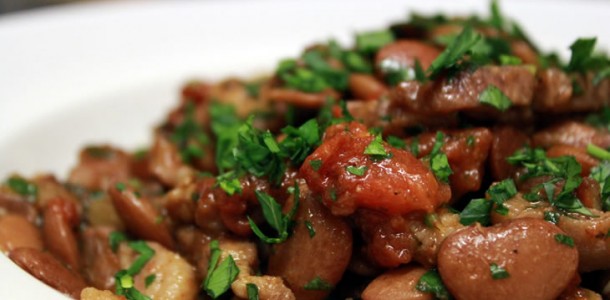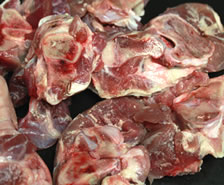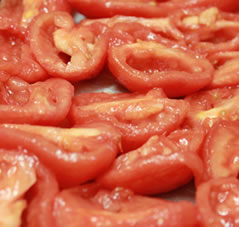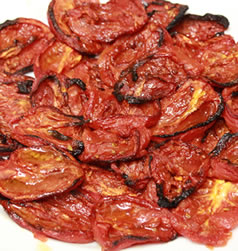- For Stock:
- 2 pounds fresh pork hock
- 2 onions, quartered
- 4 ribs celery, roughly chopped
- 3 carrots, roughly chopped
- 1/4 bunch parsley
- Kosher salt and freshly ground black pepper
- For Tomatoes:
- 16 plum or Roma tomatoes
- 1/3 cup olive oil
- Kosher salt
- For Beans:
- 1 1/2 cups dry Italian white beans (or baby Lima beans)
- 4 cups reserved pork stock
- 1 teaspoon dried thyme
- Kosher salt and fresh ground black pepper to taste
- For pork shoulder:
- 2 pounds boneless pork shoulder
- 1 large onion, diced
- 1 tablespoon garlic, diced
- 16 roasted tomatoes cut into strips
- 1 cup reserved pork stock
- Kosher salt and fresh ground black pepper to taste
- To Serve:
- 1 cup flat-leaf parsley, chopped
A cassoulet is a wonderful medieval French peasant dish flavored with meat, a good stock, and beans. It is so good, in fact, that there is an official Académie Universelle du Cassoulet whose responsibility it is to give out medals every year to those who present a rich, meaty and near perfect cassoulet. While this recipe was inspired by the traditional cassoulet and is arguably just as deep and rich in flavor as its French cousin, it is uniquely Tuscan. And that, I propose, is a good thing. The final result will literally blow your guests away.
I was hired by an Italian game restaurant in Aspen to create a dish that had the same amazing depth of flavor of a French cassoulet but had to have its roots in Tuscany and focus on the wild game for which the restaurant was known. That’s a big challenge when you have an entire Académie of folks with pitch forks at the ready for those who would dare bastardize the true cassoulet. Comforted by an entire ocean separating me from the pitch-fork wielding Frenchman, I succeeded in creating a Tuscan inspired cassoulet that earned the restaurant a silver medal.
I wanted to present this recipe to you not because it introduces any new ingredients or skills, but because it gives you the experience of how a finished dish makes it to your table from a professional kitchen. While there are a number of steps, many of which can be done a day or more in advance, the final preparation before service can be pulled off in under 30 minutes. You will put a restaurant quality dish of the highest level on the table and still have the time to mingle with your guests at leisure like an executive chef. This is why this particular recipe is fun. It is also why it reads a bit differently.
This version replaces the wild boar in the original preparation with pork shoulder and fresh pork hock for convenience. I like pork shoulder because it is a well marbled cut and packed with the delicious porkiness that we want to permeate this entire dish. We’ll also be making a pork stock and, thanks to its abundance of connective tissue, we’ll be using pork hock or pork shank to provide a rich flavor that is ideal for flavoring rustic stews like this one. We are not looking for anything cured or smoked. We want fresh pork hock which can often be found with the skin intact – all the better if you can find it. The proteins in pork skin break down during the long cooking process and yield a thick, decadent sauce that no thickener can ever replicate.
Just like in a professional kitchen, we’ll be creating this dish in five steps: making and reducing a stock, oven roasting tomatoes, cooking our beans in the reduced stock, cooking our pork shoulder and finally, minutes before service, combining them all together, bringing them up to temperature and serving. Each of these steps is normally assigned to a specific person in a professional kitchen and carried out under the watchful eye of the sous chef long before the first guest ever arrives – save the last step. This step is normally carried out as soon as you order by a line cook who knows exactly how to execute and plate the dish the same way every single time. This is the reason why your favorite dish tastes the same each and every time you order.
Each of the preparation steps is designed to enhance and concentrate the flavors of the ingredients. One of the secrets to professional cooking is reduce, reduce, reduce. Another secret is to constantly taste what you’re working on for seasoning and flavor. If you don’t like it, neither will your guests. I recommend that you start preparing this dish a couple days in advance leaving you the time to focus on the other details that will have your guests talking for days.
We will begin with the stock. The directions below includes the vegetables you need to make a stock should you not have a bag of discards. In my kitchen we keep and freeze the discards; all the onion ends and peels, the celery bottoms, carrot peels and ends, parsley stems and basically any of the aromatics that go into practically everything that you cook. There is a whole lot of flavor left in those discards and when making a stock, I just pull a one-gallon Zip-lock bag of discards out of the freezer and dump it in the stock pot.
Step one is our stock. We’ll be browning our pork hocks in the oven and adding them to a stock pot with some aromatic vegetables and about 2 1/2 gallons of water set over a fire just high enough to keep everything at a simmer. Over the course of about 5 hours, we will let our stock slowly reduce to about a gallon at which point we will strain out and discard all the solids, return the stock to the heat and continue to reduce until there is only about 1 1/2 quarts left. It takes time to break down the connective tissue and extract the flavors that compose a good stock. Don’t forget to deglaze the roasting pan by adding a bit of hot water to the pan and get up all the dark bits stuck to the bottom. This stuff is intense and will add tons of flavor to our dark savory stock.
Step two is the preparation and roasting of our tomatoes in the oven. I have to tell you, what comes out of the oven is what I call God’s candy and I always have to make extra for what I consume in the process. Essentially what we are doing by oven roasting tomatoes is concentrating the tomato flavor and natural sugars that are present in the tomatoes. I encourage you to eat one of these when they come out of the oven. There is an explosion of flavor in your mouth that tastes like the finest pasta sauce you have ever encountered; at one time sweet, tangy, bold and savory. Pay attention to this step because there is a fine line between charring your tomatoes to perfection and burning them. You can certainly pull them out of the oven before the char-point, but do yourself the pleasure of letting them go as long as possible under a watchful eye.
I recommend plum (Roma) tomatoes. They are cheap, abundant and perfect for oven roasting. Preparing the tomatoes for roasting is an easy and straight forward process of skinning them, seeding them and then roasting them. To skin them we are going to core (cut out the stem) with a paring knife and cut a small “x” on the bottom before dropping them in boiling water for about a minute. As soon as you see the skin start to pull back, remove them from the boiling water and drop them into an ice bath – a bowl filled with water and ice. This will immediately stop them from cooking and the skins will pretty much just slide off.
Next, you’ll cut them in half and run your thumbs right up the inside to loosen the seeds. Now, just hold the tomato over the sink and with a slinging motion (like your trying to get the last of the mustard out of a squeeze bottle) sling the tomato toward the sink and the seeds will come flying out. It’s not all that important to get rid of every seed. Place your peeled and seeded tomatoes face up on a baking sheet, drizzle them with an ample amount of olive oil, sprinkle them with salt and roast them in the oven. Oh, did I mention that you might want to roast extra for cooks consumption?
Step three is cooking the beans and is pretty straight forward. You’ll be cooking your beans in the stock you made in step one. Dry beans can take a while to cook and I can’t stress enough the importance of not rushing this process. The beans need to be cooked to the point that they are tender to the bite without any toothiness but not so cooked that they fall apart when stirred. They need to hold their own when everything is combined in the last step. As your beans are cooking, you want to maintain enough liquid in the pot so that the beans can move freely without packing up together.
In step four we’ll be preparing our pork shoulder by cooking it with our onions, garlic and tomatoes from step two. To get the pork shoulder ready we’ll need to cut it down into strips about 1/2 inch wide and 1/2 inch thick. The easiest way to do this is to slice the pork into planks about 1/2 in thick and then slice the planks into strips about 1/2 inch wide. We’ll be thoroughly browning our pork in olive oil in a large heavy skillet then adding our onions, garlic and tomatoes to the party before deglazing the pan with a bit of the stock we reserved to get all that wonderful flavor off the bottom of the pan.
Step five is your final step and with all of your components ready, you are only 30 minutes away from serving the meal of your life. You simply place the 5-quart heavy pot with your beans over a high fire and bring it up to a rapid boil. Add your pork shoulder and reduce the fire to maintain a low steady boil paying close attention to the level of liquid in the pot. You want a thick sauce that coats the back of a spoon. You can add water or chicken stock as needed. Cut the fire about 5 to 7 minutes before serving to allow the flavors to finishing marrying up, stir in your parsley and serve.
Directions:
For Stock:
- Liberally season pork hocks with Kosher salt and fresh ground black pepper, cover with oil and place on a baking sheet in a 400 degree oven for 30 – 40 minutes or until they are a deep rich brown.
- While the pork hocks are browning, place 2 1/2 gallons of cold water in stock pot over a high fire and add the onions, celery, carrots and parsley and bring to a boil. Lower the fire until the stock maintains a slow simmer and add browned pork hocks.
- Maintain a slow simmer for about 5-hours or until the stock has reduced to about 1-gallon. Remove and discard all the solids and continue to reduce until your volume is about 1 1/2 quarts. Taste for seasoning adding more salt and black pepper as needed. Reserve stock for later.
To Prepare Tomatoes:
- Core, peel, half and seed 16 plum or Roma tomatoes. Place the tomatoes face up on a baking sheet, drizzle liberally with olive oil and salt.
- Bake at 375 degrees for an hour then turn the oven up to 425 degrees for 20 to 30 minutes or until the tomatoes begin to char.
- Immediately remove from baking sheet, taste for seasoning adding more salt as needed.
- Cut into strips and reserve.
To Prepare Beans:
- Wash Italian white beans thoroughly, place in a bowl, add enough boiling water to cover by about 2 inches and let them soak for 4 to 6 hours.
- Discard the soak water.
- In a heavy 5-quart pot, add soaked beans, 4-cups of reserved stock, thyme and 2 teaspoons salt.
- Bring beans to a boil then reduce the heat to maintain a slow simmer, cover and cook for 1 hour. Stir occasionally to insure the beans do not stick. You may need to add 1/2 cup to 1 cup of the remaining reserved stock to maintain enough liquid in the pot so that the beans can move freely without packing up together.
- After an hour, taste beans for doneness. Beans should be tender but not mushy.
- Season with salt and black pepper as needed and reserve.
To Prepare Pork Shoulder:
- Using a sharp knife, slice boneless pork shoulder into 1/2 x 1/2 inch strips and liberally season with Kosher salt and fresh ground black pepper.
- In a large heavy skillet heated to 350 degrees, add olive oil and pork shoulder strips and thoroughly brown pork over high heat.
- Add diced onions and saute over high heat until they begin to take on color.
- Add garlic and tomato strips, stir through and deglaze the pan with remaining reserved stock.
- Taste for seasoning and reserve.
To Serve:
- Bring beans to a rapid boil over a high heat in a 5-quart heavy pot. Add pork shoulder, cover and return to a slow boil for 20 minutes.
- Uncover and continue to cook for 5 to 10 minutes reducing the liquid until it is thick enough to coat the back of a spoon.
- Remove from heat, stir in chopped parsley and serve.









Awesome!! You are The Master!!
Thank you, Laura!!